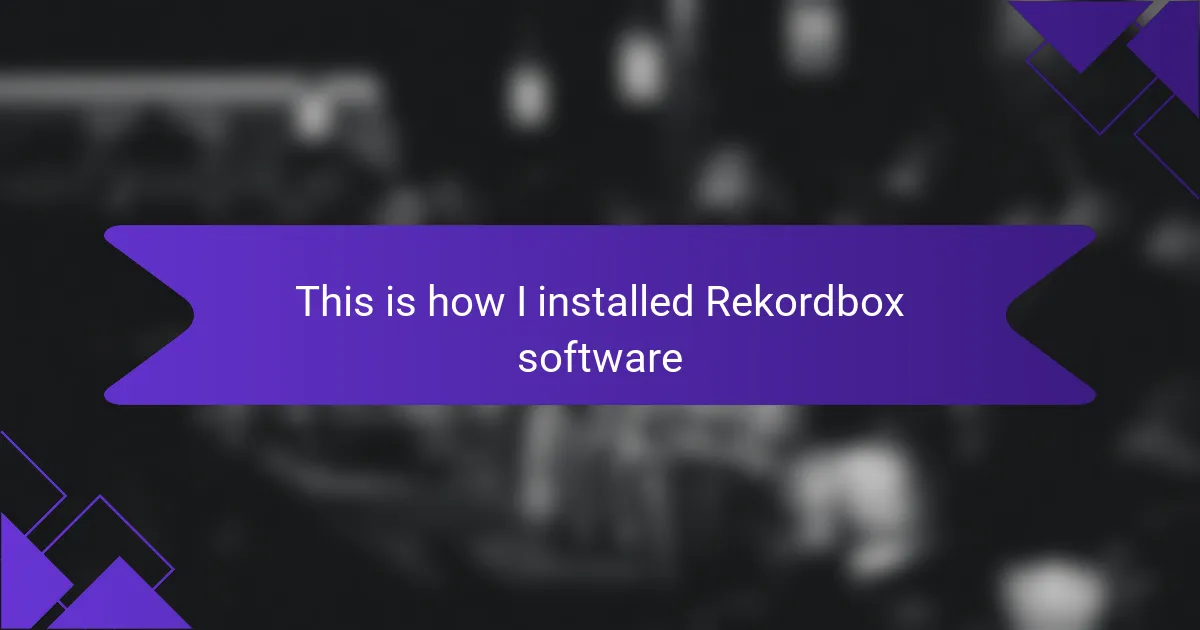Key takeaways
- DJ controllers, like the Pioneer DDJ-SX3, are essential for modern mixing, featuring components such as pads, faders, and jog wheels that enhance performance.
- The DDJ-SX3 includes dual USB ports for seamless DJ transitions and color-coded performance pads for instant visual feedback during live sets.
- Customizing settings—such as tempo range and effects—greatly impacts personal mixing style and audience connection.
- Small adjustments, like jog wheel sensitivity and pad color customization, can significantly elevate overall DJ performance and enhance audience engagement.
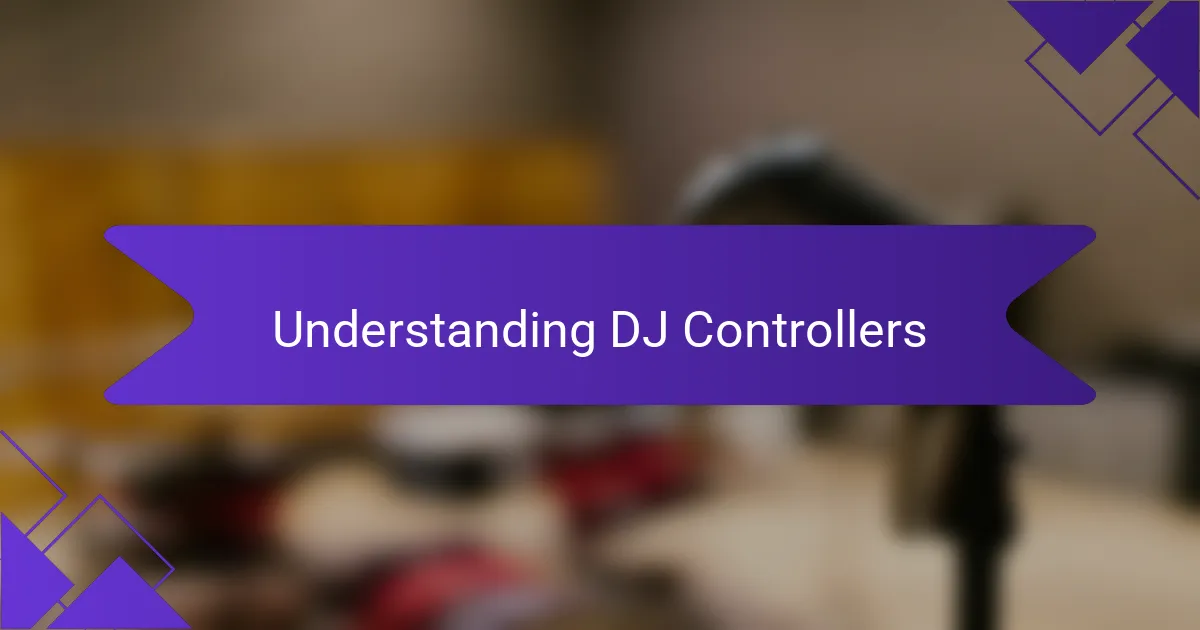
Understanding DJ Controllers
DJ controllers are essential tools for modern DJs, allowing for seamless mixing and creative expression. I still remember the first time I got my hands on a DJ controller; it felt like I was holding the key to a whole new world of sound. The DDJ-SX3, in particular, has become a favorite of mine due to its intuitive layout and responsive features.
When configuring your controller, understanding its components is crucial. Here are some key aspects to consider:
- Pads: Used for triggering samples, loops, or effects; the feel can influence how you perform.
- Faders: Control the volume and mix of tracks; smooth movement is essential for live performances.
- Jog Wheels: Enable precise track navigation and scratching; I love how responsive they are on the DDJ-SX3.
- Effect Controls: Allow you to manipulate sound in real-time; experimenting here can elevate your set.
- Input/Output Options: Ensure compatibility with your gear; a good connection can save you from potential technical hiccups.
Understanding these components has truly enhanced my mixing experience, and I hope it helps you too!
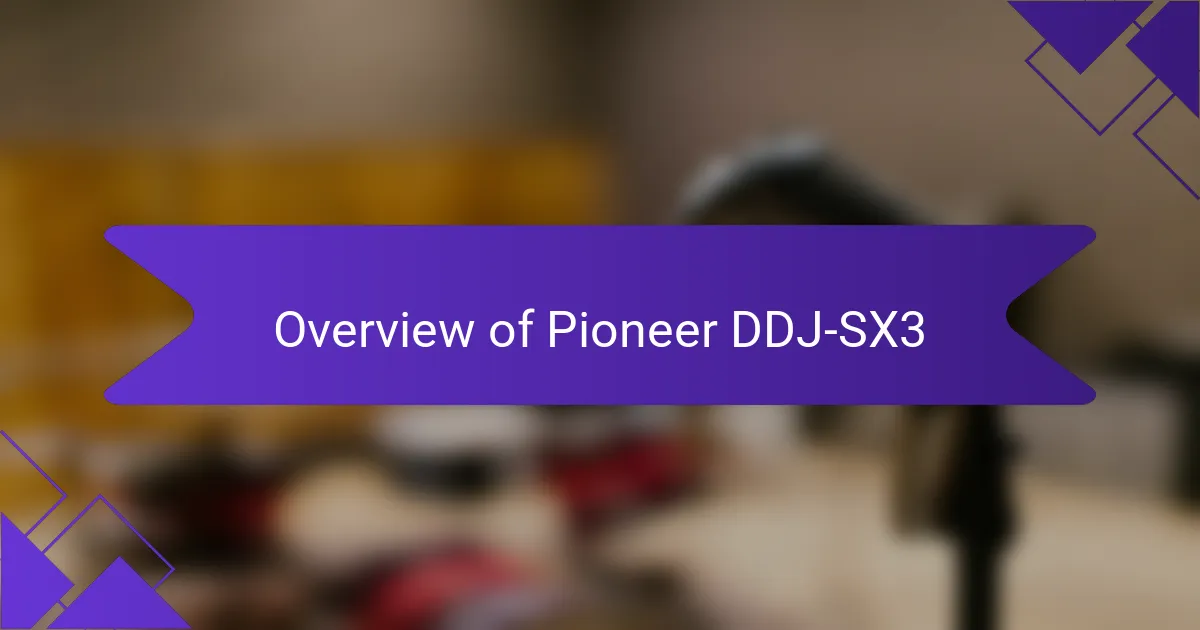
Overview of Pioneer DDJ-SX3
The Pioneer DDJ-SX3 is a powerhouse of a DJ controller that perfectly blends functionality with user-friendly design. From the moment I unpacked it, I was impressed by its robust build and sleek layout, which seemed to promise endless creative possibilities. I often find myself wondering how I ever mixed without it; it really feels like an extension of my own musical instincts.
One feature that stands out to me is the dual USB ports, which allow for seamless transitions between DJs during a set. I still remember the first time I shared the stage with another artist; being able to switch seamlessly without interrupting the flow of music was exhilarating. It’s a small yet game-changing detail that reflects how this controller is designed with performance in mind.
The color-coded performance pads are another highlight, giving me instant visual feedback on what I’m triggering. It’s as if the controller is communicating with me, allowing for a more instinctive approach to live mixing. I often find myself getting lost in the moment, and those pads help keep my energy up, making every set a memorable experience.
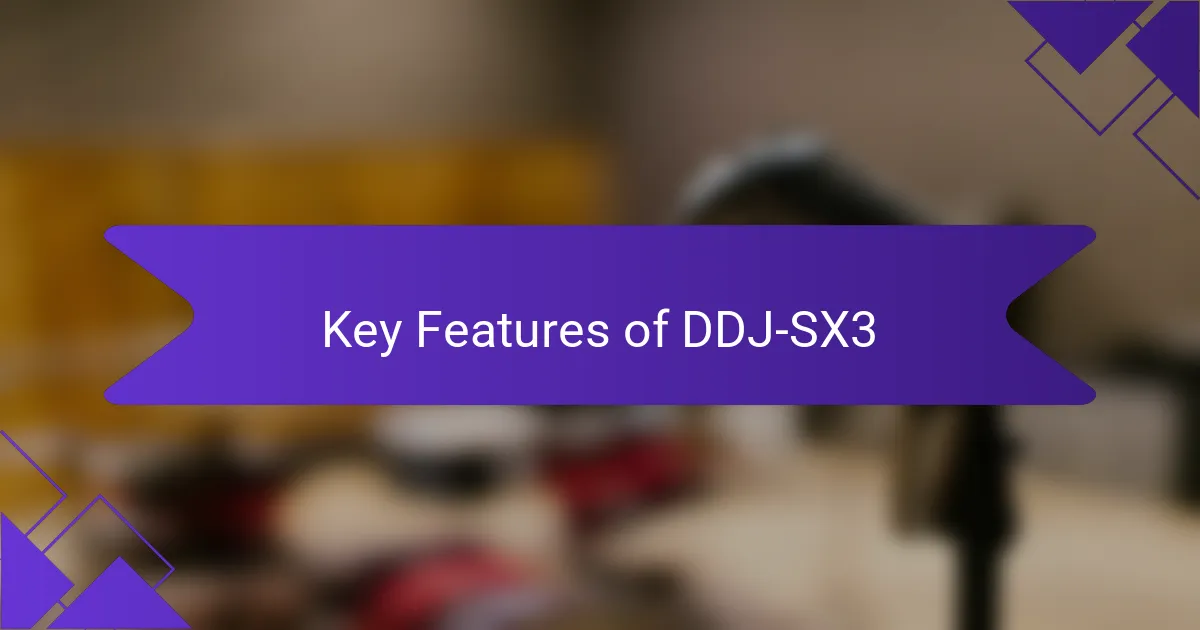
Key Features of DDJ-SX3
The Pioneer DDJ-SX3 is packed with features that truly elevate the DJ experience. One standout for me is the dual USB ports, which allow for seamless transitions between DJs or to have a backup system ready to go. I remember the first time I used the dual USB feature during a live set; it felt empowering to effortlessly switch between my laptop and my friend’s, ensuring that the energy in the room never dipped.
Another compelling feature is the onboard audio effects, including reverb and echo, which can be manipulated on the fly. I’ve found that incorporating these effects adds a unique flair to my mixes, giving me a creative outlet to experiment and enhance my performances. Here’s a quick rundown of the key features:
- Dual USB ports for easy DJ transitions
- Onboard audio effects like reverb and echo
- High-quality sound output with a built-in soundcard
- Large jog wheels for precise control
- Performance pads for triggering samples and loops
- Dedicated controls for Serato DJ Pro functions
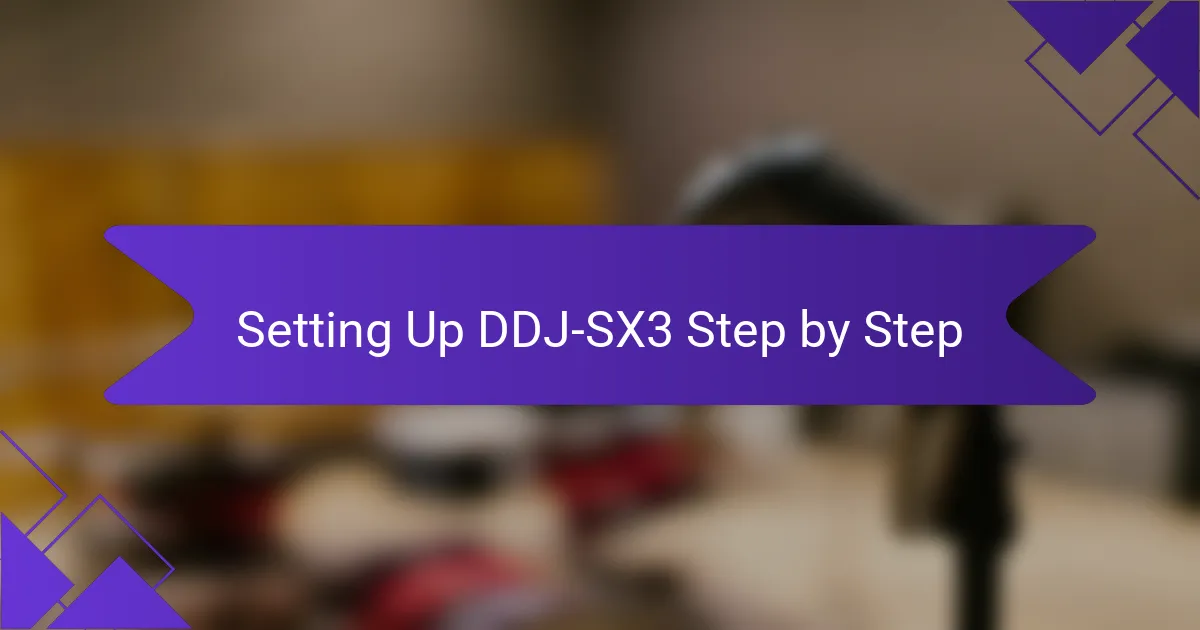
Setting Up DDJ-SX3 Step by Step
Setting up the Pioneer DDJ-SX3 was an exciting process for me, and I can confidently say that following a step-by-step approach makes all the difference. First, I connected the controller to my laptop using a USB cable, which not only powered it up but also allowed my DJ software to recognize it instantly. Next, I adjusted the audio settings to ensure that sound flowed smoothly from my speakers, and I remember the thrill of hearing my first mix come to life.
Another crucial step involved mapping the pads and knobs to align with my workflow. It was a bit of a learning curve, but once I got everything set up, the freedom to customize controls according to my preferences felt empowering. At that moment, I realized how much potential this controller had for my performances.
Here’s a quick comparison of some key aspects of the DDJ-SX3 setup process:
| Step | Description |
|---|---|
| Connection | Use a USB cable to connect the controller to the laptop. |
| Audio Setup | Configure audio settings in your DJ software for optimal sound quality. |
| Control Mapping | Customize pads and knobs to fit your unique DJing style. |
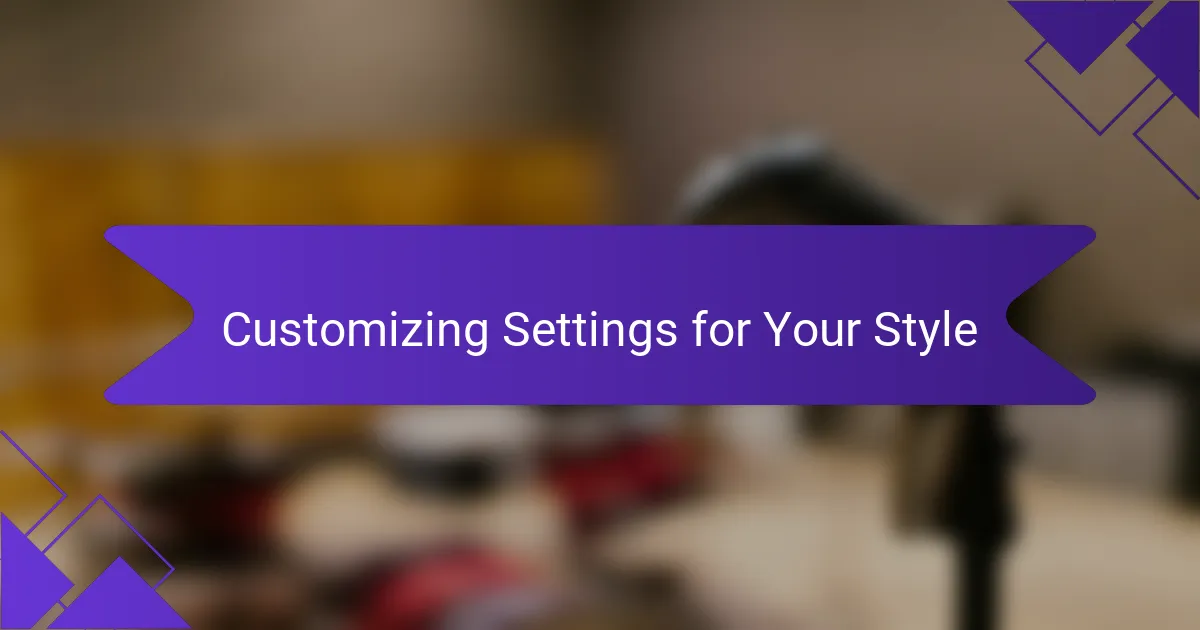
Customizing Settings for Your Style
Customizing the settings on my Pioneer DDJ-SX3 was a game-changer for my DJing experience. I remember the first time I adjusted the tempo range; it allowed me to really match my energy with the crowd as I blended tracks. Finding my unique sound became easier, and I felt more in tune with the music I was creating.
Here are some key settings I recommend customizing to match your style:
- Tempo Range: Adjust this to fit your mixing style, whether you prefer fine-tuning or going all out with broader shifts.
- Fader Sensitivity: Modify this to allow smoother transitions between tracks; I like having more control when I’m fading in and out.
- Effects Settings: Experiment with different effects to find what enhances your performance; I found certain reverb settings really elevate the mood during my sets.
- Lighting Controls: Sync your lighting to match your beats and create a captivating atmosphere; it made a significant impact on my shows.
- Pad Functions: Customize the performance pads to trigger samples or loops that resonate with your musical personality.
These adjustments have helped me connect more with my audience and enhance my overall performance.

Tips for Enhanced Performance
When I first started using my Pioneer DDJ-SX3, I quickly realized that enhancing performance is all about small tweaks that make a big difference. I’ve discovered that adjusting the sensitivity settings of the jog wheels can really improve my mixing precision. The difference it made in my transitions was like night and day; there’s just something satisfying about perfecting that scratch technique.
Here are some tips I found helpful for elevating my DJ performance with the DDJ-SX3:
- Customize the Performance Pad Colors: Choose colors that resonate with you and help you identify cues quickly.
- Use the Pad Modes to Your Advantage: Explore different modes like Hot Cue and Loop to keep your sets dynamic.
- Prioritize Firmware Updates: Keeping your controller’s firmware updated ensures you have the latest features and fixes.
- Organize Your Playlist Wisely: Curate your track selection for flow and energy, allowing for seamless transitions.
- Incorporate Effects Sparingly: But strategically; using effects at the right moment can create memorable moments during your set.
These adjustments and practices not only make a tangible difference in performance but also deepen my connection with the music and the crowd.


